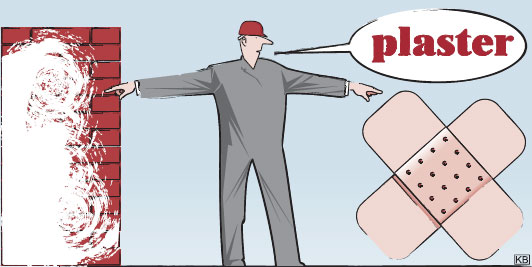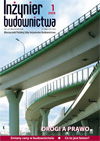Those who enter heaven may find the outer walls plastered with creeds, but they won’t find any on the inside.
Josh Billings

Composition
Plaster is a compound material made mostly of cement, gypsum and lime, to which complementary substances, like sand or fibers, can be added in order to make it more stable and compact. Plaster is frequently applied in two or three coats, whereby the first ones contain sand, cement and gypsum or lime whilst the final one is richer in lime, forming in consequence a smooth and hard surface. In former versions of external plasters also asbestos fibres were used.
There are many different types of plaster available, of which the basic ones are gypsum based plaster and cement based plaster. The first is used only for internal plastering and the latter also outd class=”inside1″oors due to its low susceptibility to dampness.
Properties
The major role of external plaster is to make the outer surface of the building waterproof and more resistant to the pressures of wind and sunshine, as well as to provide thermal and sound insulation of interior areas. Although it isn’t primarily a load-bearing material, the fireproofing properties of plaster are essential to the building’s strength. This is due to the fact that the protective insulation layer holds back the rush of heat into the building’s structural elements and consequently prevents it from collapsing.
Plaster’s role is also one of decoration. It can be easily shaped, even after drying, into various surface finishes whereas chemical additives can give it a pleasant and consistent colour and texture. In such a case there’s no need to apply a coating of paint to the external walls.
Application of the render
The first coat of plaster should have good adhesion to the substrate, which should be firm and free from dirt, dust or grease. Depending on the type of surface and the type of required render finish, plaster should be correctly mixed in a cement-mixer with great attention being paid to proportioning, water-cement ratio and grading. A ready-to-use plaster is also available.
 1. Dopasuj słowa znad tekstu do słów o podobnym znaczeniu wyróżnionych w tekście.
1. Dopasuj słowa znad tekstu do słów o podobnym znaczeniu wyróżnionych w tekście.
 2. Przetłumacz następujące fragmenty tekstu na język polski
2. Przetłumacz następujące fragmenty tekstu na język polski
in order to make it more stable and compactaby uczynic go bardziej stabilnym i spoistym
whereby the first ones contain sandczym pierwsze zawieraja piasek
whilst the final one is richer in limepodczas gdy pierwsze sa bogatsze w wapno
due to its high susceptibility toz powodu malej podatnosci na
prevents it from collapsingchroni go przed zawaleniem sie
plaster’s role is also one of decorationrola tynku jest równiez dekoracja (nie: jedna z)
with great attention being paid tozwracajac duza uwage na
 3. Dopasuj materiały budowlane i narzędzia zamieszczone w tabeli (1-8) do ich definicji (a-h)
3. Dopasuj materiały budowlane i narzędzia zamieszczone w tabeli (1-8) do ich definicji (a-h)
|
1 |
a |
a building material similar to mortar or cement |
|
|
2 |
b |
any layer lying underneath another |
|
|
3 |
c |
a sheet building material consisting of gypsum |
|
|
4 |
d |
a tool with a handle and flat metal blade; used |
|
|
5 |
e |
a substance applied to masonry walls |
|
|
6 |
f |
a tool on which plaster is normally held before being |
|
|
7 |
g |
a bar with one edge accurately straight, used |
|
|
8 |
h |
a tool used for applying plaster |
{mospagebreak}
 4. Podaj słownie następujące liczby
4. Podaj słownie następujące liczby
1) 1,537one thousand five hundred and thirty-seven
2) 2,478,198two million four hundred (and) seventy-eight thousand, one hundred (and) ninety-eight
3) 2,078two thousand (and) seventy-eight
4) 0.04nought/ oh/ zero point oh four
5) 3/4three and a quarter
 5. Przetłumacz, zapisując liczby tak, jak się je wymawia
5. Przetłumacz, zapisując liczby tak, jak się je wymawia
Nasze biuro jest na 25 piętrze, trzeci pokój po lewej stronie.Our office is on the twenty-fifth floor, the third room on the left
Odległość między naszymi domami to 2,5 km.The distance between our houses is two and a half kilometres
Rachunek wynosi €10.45.The bill is ten euros forty five
Byłam w Kopenhadze 15.07.1956.I was in Copenhagen on the fifteenth of March nineteen fifty-six
Mam zamiar poświęcić 2/3 wolnego czasu na naukę i sport.I’m going to spend two thirds of my free time on studying and doing sports.
False friends:
Consequent – słowo to nie oznacza „konsekwentny”, lecz “następujący po czymś”, przymiotnik od „w konsekwencji”, np. Mixing the plaster correctly prevents leakage and consequent damage.
Consistent – słowo to można uznać za odpowiednik polskiego „konsekwentny”, „spójny”, np. Parents must be consistent in their dealings with their children.
Study tip:
Ucząc się nowych słów, np. zwrotów specjalistycznych, należy pamiętać, jak ważną kwestią w języku angielskim jest prawidłowa wymowa. Nie wystarczy zatem poznać znaczenie słowa, należy również rozumieć skrypt fonetyczny. Nie jest to trudne, gdyż symbole fonetyczne są na ogół podobne do liter alfabetu, można nauczyć się ich również porównując zapis znanych nam słów np. „house”, „like” i na ich podstawie wnioskować znaczenie symboli w innych wyrazach. Wiele słowników zamieszcza również „klucz” do symboli fonetycznych. Rozumienie i stosowanie się do zapisu fonetycznego sprawi, że zyskamy większą samodzielność w nauce a nasze wypowiedzi będą bardziej poprawne, a co za tym idzie – zrozumiałe.

Aneta Kaproń
Artykuł zamieszczony
w „Inżynierze Budownictwa”,
styczeń 2008





